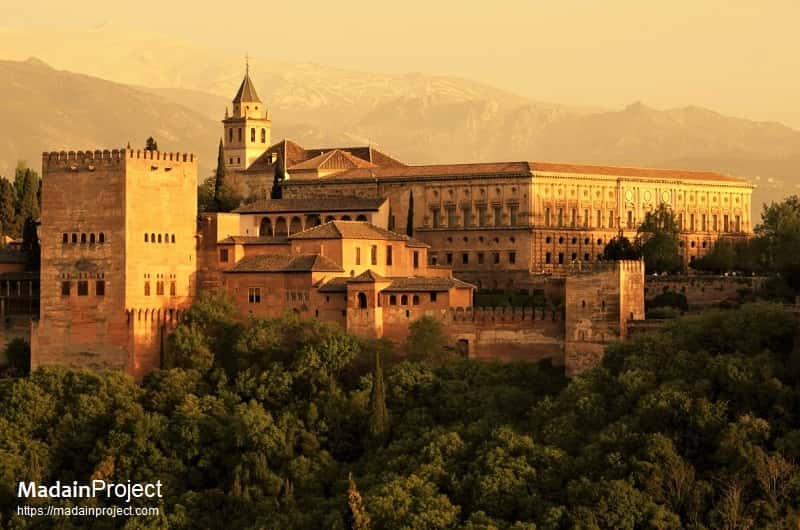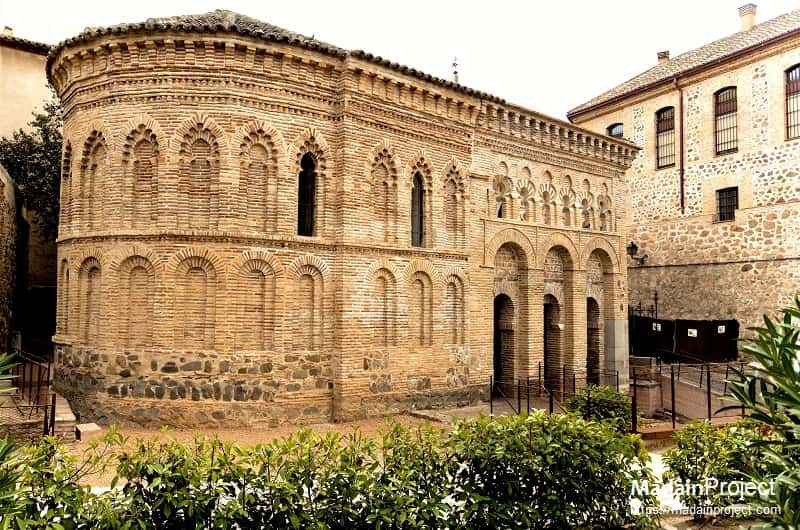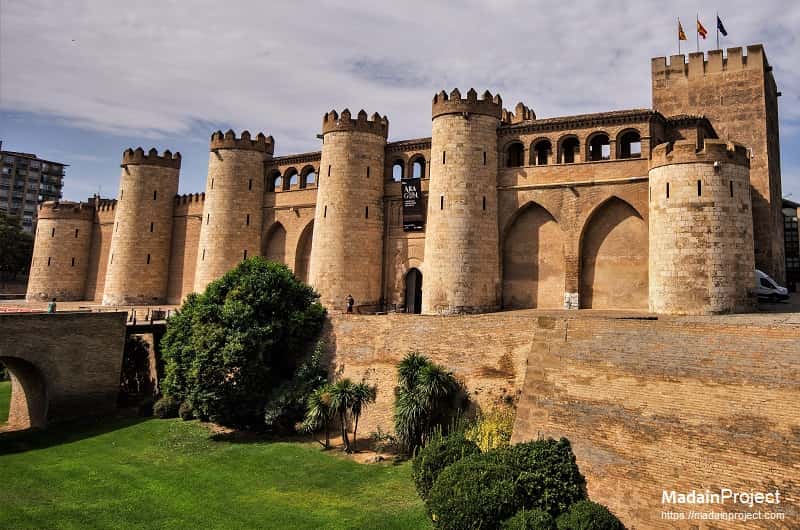Ancient al-Andalus (الأندلس) was the Muslim-ruled area of the Iberian Peninsula. The term is used by modern historians for the former Islamic states in modern Portugal and Spain. For nearly a hundred years from the ninth century to the tenth, al-Andalus extended its control from Fraxinetum over the Alpine passes which connect Italy to Western Europe.
al-Andalus was a centre of learning, and the city of Córdoba, the largest in Europe, became one of the leading cultural and economic centres throughout the Mediterranean Basin, Europe, and the Islamic world. Achievements that advanced Islamic and Western science came from al-Andalus, including major advances in trigonometry (Geber), astronomy (Arzachel), surgery (Abulcasis al Zahrawi), pharmacology (Avenzoar), and agronomy (Ibn Bassal and Abū l-Khayr al-Ishbīlī). al-Andalus became a major educational center for Europe and the lands around the Mediterranean Sea as well as a conduit for cultural and scientific exchange between the Islamic and Christian worlds.
Islamic Conquest (711-718)
The Umayyad Caliphate in Damascus sent an army led by Tariq ibn Ziyad to the Iberian Peninsula in 711. The Muslims, along with their Berber allies, defeated the Visigothic forces at the Battle of Guadalete and quickly conquered much of the Iberian Peninsula.
Umayyad Rule (711-750)
al-Andalus became part of the Umayyad Caliphate, and its first governor, Abd al-Rahman I, established the independent Emirate of Cordoba in 756. The Umayyad dynasty ruled al-Andalus for several centuries.
Cultural Flourishing (8th-10th centuries)
al-Andalus witnessed a cultural renaissance known as the Golden Age. Cities like Cordoba became centers of learning, with advancements in science, philosophy, medicine, literature, and architecture. Notable scholars like Ibn Rushd (Averroes) and Ibn Sina (Avicenna) emerged during this period.
Fragmentation and Taifas (11th century)
Political disunity and internal strife led to the fragmentation of al-Andalus into small, independent taifas (city-states) in the 11th century. This weakened the Muslim presence and made the region vulnerable to external threats.
Almoravid and Almohad Periods (11th-13th centuries)
Berber dynasties like the Almoravids and Almohads intervened to reunify al-Andalus and defend against Christian Reconquista advances. However, their efforts were temporary, and internal conflicts persisted.
Christian Reconquista (711-1492)
Christian kingdoms in the northern part of the peninsula gradually reclaimed territories from Muslim rule through the Reconquista. Major milestones include the capture of Toledo in 1085 and the fall of Seville in 1248. The Nasrid Emirate of Granada persisted until 1492.
Fall of Granada (1492)
The Catholic Monarchs, Ferdinand II of Aragon and Isabella I of Castile, completed the Reconquista by capturing Granada in 1492. The event marked the end of Muslim rule on the Iberian Peninsula.
Legacy
al-Andalus left a lasting legacy in terms of architecture, science, literature, and cultural exchange. The blending of Islamic, Christian, and Jewish influences contributed to a diverse and rich cultural heritage.

Qurtaba (Cordoba), was a prominent and highly significant city during the Islamic rule of al-Andalus, which served as the capital of the Umayyad Caliphate of Cordoba, one of the most powerful and culturally advanced Muslim states in the Iberian Peninsula. Under the Umayyads, Cordoba became a center of learning and culture, known for its grand architecture, including the Great Mosque of Cordoba (La Mezquita), which remains one of the most iconic symbols of Islamic Spain. Read more

Ishbiliya is the Arabic name for Seville, a city in modern-day Spain, and it was a significant center during the Islamic rule of al-Andalus. Seville, or Ishbiliya, became the capital of the Taifa of Seville after the fragmentation of the Umayyad Caliphate of Cordoba in the 11th century CE. During the period of the taifas (independent Muslim states), Seville experienced a rich cultural and artistic flourishing. It was known for its impressive architecture, gardens, and vibrant intellectual life. Read more

Ġarnāṭa is the Arabic name for Granada, which was a highly significant and well-known urban and civic center during the Islamic rule of al-Andalus. Granada holds a special place in the history of al-Andalus, particularly due to its role as the last Muslim stronghold on the Iberian Peninsula. The Muslim Granada is renowned for the al-Hamra, a palace-fortress complex constructed during the Nasrid period, considered to be one of the finest examples of Islamic architecture. Read more

Toledo was a major cultural and intellectual center during the Islamic rule of al-Andalus. It was known for its diverse population, which included Muslims, Christians, and Jews, contributing to a vibrant and cosmopolitan atmosphere. The city became renowned for its translation movement, where scholars translated classical Greek and Roman works into Arabic preserving and transmitting knowledge to the Islamic and the rest of the world. Read more

Under Islamic rule, Zaragoza thrived as a center for trade and intellectual activities. The city was strategically located along the Ebro River, making it an important hub for commerce and communication. Zaragoza's cultural and scholarly achievements contributed to the overall vibrancy of al-Andalus during its Muslim period. In 1118 CE, Zaragoza fell to the Christian Kingdom of Aragon under Alfonso I. Read more

Medina Az-Zahra (the radient city) is a historical and archaeological site located near Qurtaba in modern-day Spain. It was a magnificent palace-city built by Abd al-Rahman III, the first Caliph of the Umayyad Caliphate of Qurtaba. The construction of Medina Az-Zahra began in 936 CE and was completed in 940 CE. It served as the official residence of the Caliph and the administrative center of the caliphate. Read more
Although the current name is derived from Arabic, Jabal Ṭāriq (جبل طارق), lit. 'Mount of Tariq', or 'The rock of Tariq', (named after the eighth-century CE Moorish-Muslim military leader Tariq ibn Ziyad) the history of Gibraltar predates the Islamic period, and it has been inhabited since ancient times. The Phoenicians and later the Romans recognized its strategic significance. That continues to be its name in Arabic. The modern name "Gibraltar", applies to the small peninsula on the southern Iberian coast near the entrance of the Mediterranean Sea. The peninsula has evolved from a place of reverence in ancient times into "one of the most densely fortified and fought-over places in Europe".
The name 'Alhambra' appears towards the end of the 9th century CE in a variety of different forms, the most common being al-Qalat al-Hamra, 'the red castle' due to the colour of the clay used in the walls. The palace complex of the Alhambra, Qasr Alhamrā; literaly meaning the red one, originates from the period of Islamic-Moorish period (Nasrid sultans). This 'city within a city' was built in the 13th century by the Moors on Sabika hill in Granada. After the city of Granada fell to the Catholics in 1492 CE, this palace was also taken in possession. The Alhambra as we know it today dates mainly to the second half of the 8th year of Hijrah / 14th century CE with significant later modifications. It is the only Andalusian palace with a set of inscriptions that explain the architecture and gardens.

"Jameh al-Qurṭuba" refers to the Great Mosque of Cordoba, also known as the Mezquita or the Mosque-Cathedral of Cordoba. It is one of the most famous and remarkable monuments in the Islamic architecture of al-Andalus, located in the city of Cordoba, Spain. The mosque underwent multiple expansions and renovations over the centuries, with each ruler leaving their mark on the architecture. Read more

The al-ḥamrā is one of the most iconic examples of Islamic architecture in the Iberian Peninsula and is closely associated with the last Muslim dynasty in Spain, the Nasrid Dynasty. The Nasrid rulers constructed the Alhambra during the 13th and 14th centuries, making it a symbol of their power and sophistication. The Alhambra stands as a testament to the architectural and artistic achievements of al-Andalus during its later Muslim period. Read more

The Torre del Oro was constructed during the early thirteenth century CE, well after the decline of the Umayyad Caliphate of Qurtaba and the establishment of various smaller taifas (independent Muslim states) in the Iberian Peninsula. Its construction is associated with the Almohad dynasty, a later Islamic ruling power in the region. The Torre del Oro is located on paseo Cristóbal Colón, on the bank of the Guadilquivir river. Read more

Today known as the la-Giralda, the minaret originally belonged to now non-extant Islmic period Great Mosque of Ishbiliya. The mosque, originally constructed during the Islamic rule of al-Andalus, was later converted into a cathedral after the Reconquista. The minaret which was converted in to a bell-tower during the Christianization of al-Andalus is the only remnant of the Great Mosque. Read more

The Torre de la Plata, literally meaning the "Tower of Silver" (برج الفضة), is an octagonal military fortification tower in al-Andalusia, located in present-day Seville, southern Spain. It was constructed during the Almohad Caliphate. Read more

Today known as the Mosque of Cristo de la Luz, is one of the few surviving mosques from the period of al-Andalus in the Iberian Peninsula. The mosque exhibits a combination of Umayyad and Mudéjar architectural styles. It is a small but well-preserved structure that reflects the elegance and simplicity characteristic of Islamic architecture. Read more

The Aljafería Palace, constructed during the 11th century CE when the city was under the rule of the Banu Hud dynasty, is a prime example of Islamic architecture in historic region of al-Andalus. It features horseshoe arches, intricate stucco work, and decorative tilework. After the Christian Reconquista of Zaragoza in the 12th century, the Aljafería underwent modifications to suit Christian tastes. The integration of Mudéjar elements, a style that reflects the influence of Islamic art and architecture in Christian territories, is particularly evident. Read more

The Salón Rico, also known as the Rich Hall, is a magnificent reception hall located in the archaeological site of Medina Az-Zahra, near Cordoba in present-day Spain. Medina Az-Zahra is a palatial city built by Abd al-Rahman III, the first Caliph of the Umayyad Caliphate of Cordoba, during the 10th century. The Salón Rico is one of the most splendid and well-preserved halls within the complex. It served as a ceremonial space for hosting important events, receptions, and gatherings during the caliphate. Read more

The Mosque of Medina Az-Zahra, also known as the Mosque of the Caliphs, was a grand mosque located in the palatial city of Medina Az-Zahra, near Cordoba, in al-Andalus (Islamic Spain). Medina Az-Zahra was constructed during the 10th century under the rule of Abd al-Rahman III, the first Caliph of the Umayyad Caliphate of Cordoba. The Mosque of Medina Az-Zahra was an integral part of the broader architectural complex that included palaces, administrative buildings, and gardens. Read more

The Generalife was originally designed as a rural retreat for the Nasrid rulers, providing a serene escape from the urban center of the Alhambra. The complex includes a palace with beautifully decorated rooms and several courtyards. The gardens of the Generalife are known for their lush greenery, vibrant flowers, and carefully planned landscaping and water plays a prominent role in the design of the Generalife's gardens. The Nasrid Dynasty's influence is evident in the design principles that emphasize symmetry, geometric patterns, and the harmonious integration of architecture and nature. Read more

Medina Az-Zahra, also known as Madinat al-Zahra, was once a grand palatial city and administrative center built during the 10th century under the rule of Abd al-Rahman III, the first Caliph of the Umayyad Caliphate of Cordoba. Medina Az-Zahra, designed with a hierarchical layout, was renowned for its opulent architecture, featuring grand palaces, administrative buildings, gardens, and mosques. The buildings were adorned with exquisite decorations, including intricate stucco work, mosaic tiles, and carved marble. Read more

The Great Mosque of Ishbiliya was originally built in the ninth century CE, and it served as a place of worship for the Muslim community. However, after Seville was recaptured by Christian forces in the thirteenth century CE, the mosque was consecrated as a Christian cathedral, now known as the Seville Cathedral. Read more
Al-Andalus, the Iberian territory ruled by Islam from the eighth to the fifteenth centuries, was home to a flourishing philosophical culture among Muslims and the Jews who lived in their midst. Andalusians spoke proudly of the region's excellence, and indeed it engendered celebrated thinkers such as Maimonides and Averroes.
See on Amazon
This is the first study in English of the political history of Muslim Spain and Portugal, based on Arab sources. It provides comprehensive coverage of events across the whole of the region from 711 to the fall of Granada in 1492. Up till now the history of this region has been badly neglected in comparison with studies of other states in medieval Europe.
See on Amazon
The Iberian Peninsula was conquered by Islamic forces in 711 AD and this presence continued in this part of Europe for 900 years.This new book tells the intriguing story of al-Andalus: its splendour, tolerance and conflicts. Centuries of Islamic presence in Spain and Portugal left an indelible stamp, like the wonders of the Alhambra and the Great Mosque of Cordoba.
See on Amazon
A work, in Spanish language, that will become the reference classic for those who wish to know the history of Al Andalus. We are facing one of the most important works that have been written about Al Andalus. For various reasons, its historical reality was never adequately addressed by the official doctrine, which limited itself to repeating what was so improbable about the supposed Arab invasion of 711.
See on Amazon
Signup for our monthly newsletter / online magazine.
No spam, we promise.